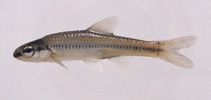| Family: |
Leuciscidae (Minnows), subfamily: Pogonichthyinae |
| Max. size: |
6.96 cm TL (male/unsexed) |
| Environment: |
benthopelagic; freshwater |
| Distribution: |
North America: lower Caney Fork system and nearby tributaries of central Cumberland River drainage in Tennessee, USA. |
| Diagnosis: |
Dorsal soft rays (total): 8-8; Anal soft rays: 7-9. Distinguished from its congeners by the following combination of characters: black-stripe around snout and along side to caudal-fin base, followed by a small black spot; black stripe along side connects a series of crescents, on at the posterior edge of each lateral-line scale; lateral line usually complete; body slender, fairly compressed with notably arched nape; dorsal-fin origin over to slightly behind pelvic-fin origin; small mouth, nearly terminal; predorsal scales 10-14, usually 11-13; gill rakers 8-11, rarely 7; peritoneum black (Ref. 58354). |
| Biology: |
Occurs usually near emergent vegetation in bedrock pools of headwaters, creeks and small rivers. These areas are prone to intermittency and harbor relatively few other fishes. This species appear to be extreme in its ability to tolerate stagnant conditions resulting from low water (Ref. 58354). Feeds on midge larvae, chydorid cladocerans, water mites, copepods and small mayflies (Ref. 10294). |
| IUCN Red List Status: |
Least Concern (LC); Date assessed: 16 April 2012 Ref. (130435)
|
| Threat to humans: |
harmless |
Source and more info: www.fishbase.org. For personal, classroom, and other internal use only. Not for publication.
